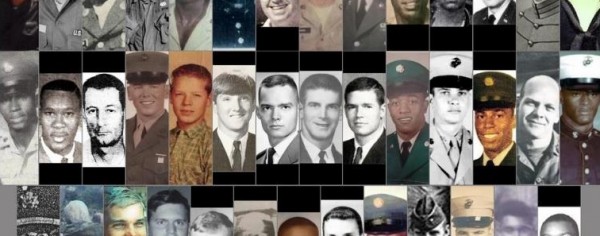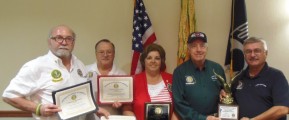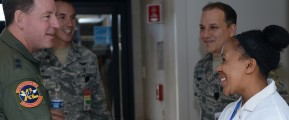All Photos Found for Deceased Vietnam Vets in a Florida County

Forest Hope is tickled pink.
Hope, president of the Alachua County, FL Chapter 1092 of the Vietnam Veterans of America, and others have finished their mission to complete a set of 41 photographs of those who died in the Vietnam War from Alachua County.
These photographs were uploaded online and sent to Washington, D.C., to be a part of the Wall of Faces, a memorial to the more than 58,000 servicemen lost in the war.
Hope said after The Sun published a May 28 article about his efforts to find the six remaining photographs, he, Beth Braun, a part-time genealogist, and Kim Davis, the county’s veteran services director, got in touch with family members of all six of those fallen Vietnam veterans.
Although happy to have completed his goal, on which he began work more than a year ago, Hope said he isn’t finished.
“It’s not over because now I need to go over to Columbia County and over to Starke to see if I can help them,” he said.
Gloria Welch Bethea, 78, found out about Hope’s efforts to find a picture of her brother, Joshua Welch Jr., from people who knew her sibling.
“Everybody who read the article was calling me,” Bethea said. “I said, ‘All (Hope) had to do is call me.’ Everyone knows Josh.”
Bethea described Welch as a “sweet guy.” She said her brother was mentored by his agriculture teacher in high school, whose goal was to get him through school, so he gave him a hog to take care of after school to help him learn responsibility.
Welch didn’t just take care of the hog.
Bethea said when her brother went into the Army after graduating high school in 1965, he would send money to help provide for her three boys.
“I was the oldest, but he always felt like he should take care of me,” Bethea said.
So when three servicemen came to tell her and her father the news of her brother’s death, it was a shock.
“Whenever I saw them, I knew,” she said, pausing a moment to pull herself to together.
She remembers her brother now with her own memorial, which consists of a picture of him alongside his Purple Heart and other medals.
“I wanted the kids to see their uncle gave his life for peace,” she said. “So we got to try to live it.”
Braun, who went as far as knocking on doors to find photographs and managed to find pictures of the final three fallen soldiers, said she’s happy to close out Alachua County. There are still 260 Florida veterans’ photos missing.
She got a lead on a photograph of Army soldier, Charles A. Gordon, which she found, which led to finding a photograph of Neal Arthur Smith, who was 19 when he died, and she found the last remaining photograph, that of Henry Bertram Wright, in Palatka High School’s online version of its 1968 yearbook.
Braun said she’s always been drawn to the Wall of Faces, noting she doesn’t make a trip to visit her children in Washington, D.C., without visiting it.
Her brother, Neil Major of Newborn, Georgia, served in the last year of the Vietnam War and came back with severe PTSD. Braun feels the photographs show the reality of the war.
“I have the obligation to put the faces on the wall for many generations to see who they were,” she said. “I want people to see their young faces.”
George Kleckley, 60, found out about the Wall of Faces from Davis and Kathleen Pagan, a liaison to the Alachua County historical commission. After they contacted him, he went to his mother’s house to find the best picture he could of Freddie Kleckley, his uncle, who was 21 and had only been in Vietnam three months when he was killed.
George Kleckley, who had just turned 9 when his uncle died, remembers writing him a letter shortly after he arrived in Vietnam.
“I told him to tell the Army I said ‘hi,’” Kleckley said, noting at the time he thought the Army was just a couple of guys.
In the letter, George Kleckley also told his uncle what he wanted for his birthday: a guitar. He said he couldn’t spell guitar, so he drew a picture of it, which wasn’t a masterpiece.
“He couldn’t figure out what that was, so he sent a letter back to my aunt and told her that he was going to buy whatever it was for me when he came home,” Kleckley said. “He never came home.”
That giving nature is something that defined Freddie Kleckley, he said. George Kleckley said his uncle was the type of person who would never hurt anyone’s feelings. He remembers a time when his aunt, Freddie Kleckley’s youngest sister, was driving his uncle home after he got home from basic training. He said she wasn’t driving well, and instead of saying that her driving wasn’t up to par, Freddie Kleckley told her he wanted to drive because he hadn’t gotten the chance to in a while.
The day he found out his uncle had died, George Kleckley said he had been in the kitchen playing with fiddler crabs.
“There was a knock on the door, and it was an Army captain, and he was coming to tell my grandmother and grandpa that my uncle had passed away,” Kleckley said. “And at the same time a fiddler crab had bit me on the finger, and I started crying and went to my room.
“So when I came in the back out to the living room, I thought they were crying for me, but they were crying for him.”
He said the living room was so quiet, you could hear a pin drop.
“It was just a cold, sad day,” he said.
But it’s been over 50 years, and now that his uncle has been added to the Wall of Faces memorial, he looks back and beams with pride.
“It shines a light on the quality of life he lived and the quality of life he desired,” he said. “It shows that he wasn’t afraid to do anything, that he was dedicated in all things that he did.”
George Kleckley said his uncle volunteered to go to war, and he went into battle and served his country proudly, never hiding or backing down.
“I call him a dedicated brother, a dedicated family member, a dedicated uncle,” George Kleckley said. “But when it all boils down, we can call him a hero.”
Source: The Gainesville Sun


